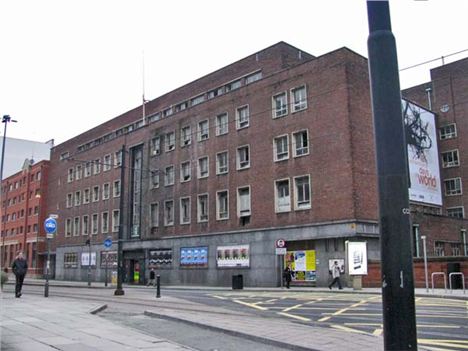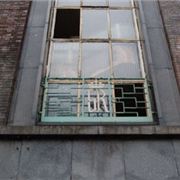340 room, 4 star hotel by 2015
BUSINESS DESK have reported (Monday 22 July) that ‘a company backed by Sukhpal Singh Ahluwalia, the entrepreneur who sold Euro Car Parts for £225m two years ago, is planning a 340-bed four star hotel at the derelict Employment Exchange in Manchester’.
Apparently Ahluwalia is still with Euro Car Parts, but also owns a property company called Dominvs Living. The plan for the Employment Exchange is to flatten it and start afresh on the site. There have been other ideas, and lapsed planning permissions, including an Ian Simpson Architects designed 44-storey tower which failed with the collapse of property company Albany Estates.
The new hotel is planned to open in 2015.
Dominvs Living say: ‘As part of a planned expansion of strategically located branded hotels in key UK cities, Dominvs Living have acquired a landmark site in Manchester City Centre for the development of a 340 Bedroom 4-Star hotel, restaurant and conference facilities.This is an important and significant development and the hotel will become a vital element of the fast growing international attraction for Manchester and its increasing stature as a major European City.’”
In April Dominvs Living acquired the Hotelier Group , operating under the Aston brand.
While the former Employment Exchange is not great architecture it’s a shame that it has to go. It represents a style and a period of architectural history rarely seen in Manchester.
Thanks be that the mocked-up picture at the top of this page is unlikely to be anything like the finished article. This design is bland in the extreme.
For more on its distinctiveness read our Good, Standard, Ugly article below, from 2008, updated to reflect this news.
THE VISUALISATION IS BY INFINITE 3D
The Good, The Standard and The Ugly: Employment Exchange, Aytoun Street
Category: Ugly (but…)
What, when, who?
The former Employment Exchange or 'dole office', on Aytoun Street. According to the Manchester edition of the Pevsner Architectural Guides, it was designed in 1936 by David Thomson. Then World War II came along and there were more pressing matters, and after that the economy stalled. It was fully fifteen years before the building opened under the supervision of the splendidly monikered E H Montague Ebbs. Is there another building that took longer from final design to build in the city?
Employment Exchange
Undead building
The empty building is doomed: it’s a dead structure standing. Demolition is staring it in the face as a Dominvs Living, a Reading-based property developer eyes the site for a four star hotel with 340 rooms. See the Yellow Box at the top of this page.
‘Brick, thin and cheap’
That - ‘Brick, thin and cheap’ - is the savage and simple description in the aforementioned Pevsner Architectural Guides of the present building. You can see why. The place is the very image of dowdy post-War Britain. It looks rationed, half-starved.
But remember it was designed before the War in the 1930s. It seems as though Mr Thompson then had an idea for giving us a bit of civic North European Modernism: maybe a bit like one of those classic town halls in Holland or Scandinavia. Then he got the budget, and it turned out to be twopence ha’penny. And after the War there was just the ha’penny left. When a tram passes by, the old Employment Exchange looks as though it's part of a movie set in communist East Berlin.
 Dreary but distinctive
Dreary but distinctive
There are bits and bobs to enjoy on the building. The massing is interesting, and the long glass tiled window on the south, over the canal, sort of exhilarating. Next to the window is a perfectly period Modernist curvy protrusion and next to that just about the largest elevated terrace in the city – big enough to fit a tennis court. Round the corner there’s some thin metal decoration over the Aytoun Street entrance carrying the letters and numbers GR IV 1951. Another year and it would have been ER II. The building also fits the street scale on this side of the street – maintaining the line and height of the nineteenth century buildings up the road.
 Mess is best
Mess is best
Half-starved can also seem lean and fit. Or different. This is the only building of this type and scale from the post-War period in the city centre. British cities tend to offer variety, with different styles of structure next to each other – it’s their charm, a product of the way we do business and look at property.
The Employment Exchange adds to that interest in Manchester. There’s also a lot of historic distinctiveness going on. How many buildings do we know which span, from conception to construction, the transition of Britain from an Imperial nation to just another European country? How many buildings span three monarchs and an abdication crisis: planned under George V, approved under Edward VIII, and built in the last year of George VI’s reign?
 Fantasy world
Fantasy world
I know a man who worked in the building in the 1960s. “It was horrible and grim: a depressing place,” he says. Perhaps it should go. But before we condemn it out of hand consider the recent building to the left (pictured a couple of images up) built for a Chinese housing association. This is in almost day-glo orange brick and a real stinker. It makes the description for the Employment Exchange as ‘brick, thin and cheap’ seem excessive and wrong.
If that sort of rubbish is allowed by the Planning Department then maybe there's a case for trying to persuade Dominvs Living to keep this building and convert it into a hotel or apartments - retain in otherwords its distinctive presence in Manchester
Fat chance.
But in some fantasy world if execution for the Employment Exchange is stayed or the developers decide to convert the existing structure into apartments, put me down for the flat with the massive terrace
You can follow Jonathan Schofield on Twitter here @JonathSchofield or connect via Google+









